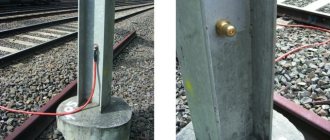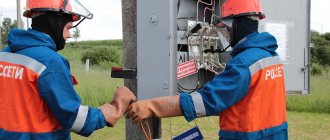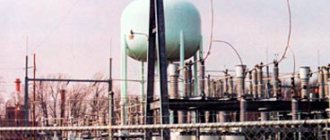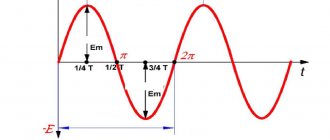Rules for the construction of electrical installations (PUE) are the main regulatory and technical document that guides designers when calculating electrical installations of all types and modifications.
In other words, PUE are rules that describe the principles of constructing electrical devices, as well as the basic requirements for power systems, electrical components, elements and communications.
View on the website
In fact, the PUE is the Bible and the main reference book for any qualified electrician. If a master comes to you who does not know what the Electrical Installation Rules are, he is not an electrician. Hit him in the neck.
The rules described in the PUE apply to newly constructed or reconstructed electrical installations of direct and alternating current with voltage up to 750 (kV), including special electrical installations.
Currently, the PUE is in force on the territory of the Russian Federation in the form of separate sections and chapters of the 7th edition and existing sections and chapters of the 6th edition.
History of the creation of the Rules
PUE has existed for more than 65 years (the first edition was published back in 1949). Due to the constant development of technology, the emergence of new technologies, and increased requirements for electrical safety and reliability of electrical installations, these rules are continuously supplemented and revised.
For example, the fifth edition was published in separate sections from 1976 to 1982. PUE 6 was developed and put into effect by the USSR Ministry of Energy and Electrification on June 1, 1985, and most of it is still in effect to this day.
The outdated chapters of PUE 6 are gradually being replaced by the corresponding chapters of PUE 7, as they are developed taking into account the most modern GOSTs, SNiPs and recommendations of working groups. Thus, the 6th edition of the PUE is still valid, with the exception of some outdated chapters (see the list below).
In the period from 2000 to 2003, the following chapters of PUE 6 lost force (and accordingly chapters of PUE 7 came into force):
- July 1, 2000 - section 6 in its entirety, as well as chapters 7.1, 7.2;
- January 1, 2003 - chapters 1.1, 1.2, 1.7, 7.5, 7.6;
- September 1, 2003 - Chapter 1.8;
- October 1, 2003 - chapters 2.4, 2.5;
- November 1, 2003 - chapters 4.1, 4.2.
Electrolaboratory » Questions and answers » PUE 7th edition » PUE. 6th edition with changes
Rules for electrical installations. SIXTH EDITION, revised and expanded, with changes
INCLUDED are all changes executed during the period from August 31, 1985 to December 30, 1997 and agreed, in the necessary part, with the State Construction Committee of Russia and the State Mining and Technical Supervision Authority of Russia.
Added changes from 07/14/98.
Section 6 and chapters 7.1, 7.2 are as revised in the seventh edition (1999)
Chapters 1.1, 1.2, 1.7, 1.9, 7.5, 7.6, 7.10 are as revised in the seventh edition (2002)
Chapters 1.8, 2.4, 2.5 are as revised in the seventh edition (2003)
Approved by order No. 204 of July 8, 2002, to be put into effect on January 1, 2001.
TABLE OF CONTENTS
Chapter 1.1. General part (2002 edition)
1.1.1-1.1.18. Application area. Definitions1.1.19-1.1.39. General instructions for electrical installations
Chapter 1.2. Electricity supply and electrical networks (2002 edition)
1.2.1-1.2.10. Application area. Definitions1.2.11-1.2.16. General requirements 1.2.17-1.2.21. Categories of electrical receivers and ensuring reliability of power supply 1.2.22-1.2.24. Voltage levels and regulation, reactive power compensation
Chapter 1.3. Selection of conductors by heating, economic current density and corona conditions
1.3.1. Scope 1.3.2 - 1.3.9. Selection of conductor sections for heating 1.3.10 - 1.3.11. Permissible long-term currents for wires, cords and cables with rubber or plastic insulation 1.3.12 -1.3.21. Permissible long-term currents for cables with impregnated paper insulation 1.3.22 -1.3.24. Permissible long-term currents for bare wires and buses 1.3.25 - 1.3.32. Selection of conductor cross-section based on economic current density 1.3.33. Checking conductors for corona and radio interference conditions
Chapter 1.4. Selection of electrical devices and conductors according to short circuit conditions
1.4.1. Scope 1.4.2 - 1.4.8. General requirements 1.4.9 - 1.4.13. Determination of short circuit currents for the selection of devices and conductors 1.4.14 - 1.4.15. Selection of conductors and insulator, testing of supporting structures under the conditions of dynamic action of short circuit currents 1.4.16 -1.4.18. Selection of conductors according to heating conditions during a short circuit 1.4.19 - 1.4.22. Selection of devices by switching capacity
Chapter 1.5. Electricity metering
1.5.1 - 1.5.3. — Scope, definitions 1.5.4 — 1.5.5. — General requirements 1.5.6 — 1.5.12. Installation points for electricity metering devices 1.5.13 - 1.5.15. Requirements for settlement meters 1.5.16 - 1.5.26. Accounting using instrument transformers 1.5.27 - 1.5.38. Installation of meters and electrical wiring to them 1.5.39 - 1.5.44. Technical accounting
Chapter 1.6. Electrical measurements
1.6.1. Scope 1.6.2 - 1.6.5. General requirements 1.6.6 - 1.6.8. Current measurement 1.6.9 - 1.6.11. Voltage measurement 1.6.12. Insulation monitoring 1.6.13 - 1.6.15. Power measurement 1.6.16 - 1.6.18. Frequency measurement 1.6.19. Measurement during synchronization 1.6.20 - 1.6.23. Registration of electrical quantities in emergency modes
Chapter 1.7. Grounding and electrical safety precautions (2002 edition)
1.7.1-1.7.48. Application area. Terms and definitions 1.7.49-1.7.66. General requirements 1.7.67-1.7.72. Measures for protection against direct contact 1.7.73-1.7.75. Measures to protect against direct and indirect contact 1.7.76-1.7.87. Protective measures for indirect contact 1.7.88-1.7.95. Grounding devices for electrical installations with voltages above 1 kV in networks with an effectively grounded neutral 1.7.96-1.7.99. Grounding devices for electrical installations with voltages above 1 kV in networks with an insulated neutral 1.7.100-1.7.103. Grounding devices for electrical installations with voltages up to 1 kV in networks with a solidly grounded neutral 1.7.104. Grounding devices for electrical installations with voltages up to 1 kV in networks with an insulated neutral 1.7.105-1.7.108. Grounding devices in areas with high earth resistivity 1.7.109-1.7.112. Grounding conductors 1.7.113-1.7.118. Grounding conductors 1.7.119-1.7.120. Main grounding bus 1.7.121-1.7.130. Protective conductors (PE conductors) 1.7.131-1.7.135. Combined neutral protective and neutral working conductors (PEN conductors) 1.7.136-1.7.138. Conductors of the potential equalization system 1.7.139-1.7.146. Connections and connections of grounding, protective conductors and conductors of the equalization and potential equalization system 1.7.147-1.7.154. Portable electrical receivers 1.7.155-1.7.169. Mobile electrical installations 1.7.170-1.7.177. Electrical installations of animal premises
Chapter 1.8. Acceptance testing standards
1.8.1 - 1.8.12. General provisions 1.8.13. Synchronous generators and compensators 1.8.14. DC machines 1.8.15. AC electric motors 1.8.16. Power transformers, autotransformers, oil reactors and grounding arc suppression reactors (arc suppression coils) 1.8.17. Measuring current transformers 1.8.18. Voltage transformers 1.8.19. Oil switches 1.8.20. Air circuit breakers 1.8.21. SF6 circuit breakers 1.8.22. Vacuum circuit breakers 1.8.23. Load switches 1.8.24. Disconnectors, separators and short circuiters 1.8.25. Complete distribution devices for indoor and outdoor installation (KRU and KRUN) 1.8.26. Complete conductors (busbars) 1.8.27. Prefabricated and connecting busbars 1.8.28. Dry current-limiting reactors 1.8.29. Electrostatic precipitators 1.8.30. Capacitors 1.8.31. Valve arresters and surge suppressors 1.8.32. Tubular arresters 1.8.33. Fuses, fuses-disconnectors with voltages above 1 kV 1.8.34. Bushings and bushings 1.8.35. Suspension and support insulators 1.8.36. Transformer oil 1.8.37. Electrical devices, secondary circuits and electrical wiring with voltage up to 1 kV 1.8.38. Rechargeable batteries 1.8.39. Grounding devices 1.8.40. Power cable lines 1.8.41. Overhead power lines with voltage above 1 kV
Chapter 1.9. Insulation of electrical installations (2002 edition)
1.9.1-1.9.6. Application area. Definitions 1.9.7-1.9.9. General requirements 1.9.10-1.9.17. Insulation of overhead lines 1.9.18-1.9.26. External glass and porcelain insulation of electrical equipment and outdoor switchgear 1.9.27. Selection of insulation according to discharge characteristics 1.9.28-1.9.43. Determination of the degree of pollution 1.9.44-1.9.54. Usage rates of the main types of insulators and insulating structures (glass and porcelain)
Chapter 2.1. Electrical wiring
2.1.1 - 2.1.12. Scope, definitions 2.1.13 - 2.1.30. General requirements 2.1.31 - 2.1.51. Selecting the type of electrical wiring, choosing wires and cables and the method of laying them 2.1.52 - 2.1.65. Open electrical wiring indoors 2.1.66 - 2.1.68. Hidden electrical wiring indoors 2.1.69 - 2.1.74. Electrical wiring in the attic 2.1.75 - 2.1.79. External electrical wiring
Chapter 2.2. Current conductors with voltage up to 35 kV
2.2.1 - 2.2.4. Scope, definitions 2.2.5 - 2.2.18. General requirements 2.2.19 - 2.2.27. Current conductors for voltages up to 1 kV 2.2.28 - 2.2.32. Current conductors for voltages above 1 kV 2.2.33 - 2.2.40. Flexible conductors for voltages above 1 kV
Chapter 2.3. Cable lines with voltage up to 220 kV
2.3.1 - 2.3.10 - Scope, definitions 2.3.11 - 2.3.24. General requirements 2.3.25 - 2.3.34. Choosing a laying method 2.3.35 - 2.3.53. Selection of cables 2.3.54 - 2.3.64. Feeding devices and oil pressure signaling of cable oil-filled lines 2.3.65 - 2.3.70. Connections and terminations of cables 2.3.71 - 2.3.75. Grounding 2.3.76 - 2.3.82. Special requirements for cable management of power plants, substations and switchgears 2.3.83 - 2.3.101. Laying cable lines in the ground 2.3.102 - 2.3.111. Laying cable lines in cable blocks, pipes and reinforced concrete trays 2.3.112 - 2.3.133. Laying cable lines in cable structures 2.3.134 - 2.3.135. Laying cable lines in industrial premises 2.3.136 - 2.3.145. Underwater laying of cable lines 2.3.146 - 2.3.150. Laying cable lines in special structures
Chapter 2.4. Overhead power lines with voltage up to 1 kV (2003 edition)
2.4.1-2.4.4. Application area. Definitions 2.4.5-2.4.10. General requirements 2.4.11-2.4.12. Climatic conditions 2.4.13-2.4.26. Wires. Linear fittings 2.4.27-2.4.34. Location of wires on supports 2.4.35-2.4.37. Insulation 2.4.38-2.4.49. Grounding. Surge protection 2.4.50-2.4.54. Supports 2.4.55-2.4.70. Dimensions, intersections and approaches 2.4.71-2.4.89. Intersections, approaches, joint suspension of overhead lines with communication lines, wire broadcasting and RK 2.4.90-2.4.95. Intersections and approaches of overhead lines with engineering structures
Chapter 2.5. Overhead power lines with voltages above 1 kV (2003 edition)
2.5.1-2.5.7. Application area. Definitions 2.5.8-2.5.18. General requirements 2.5.19-2.5.24. Requirements for the design of overhead lines, taking into account the features of their repair and maintenance 2.5.25-2.5.37. Protection of overhead lines from environmental influences 2.5.38-2.5.74. Climatic conditions and loads 2.5.75-2.5.85. Wires and lightning protection cables 2.5.86-2.5.96. Location of wires and cables and distances between them 2.5.97-2.5.115. Insulators and fittings 2.5.116-2.5.134. Surge protection, grounding 2.5.135-2.5.149. Supports and foundations 2.5.150-2.5.177. Large transitions 2.5.178-2.5.200. Suspension of fiber-optic communication lines on overhead lines 2.5.201-2.5.205. Passage of overhead lines through unpopulated and inaccessible areas 2.5.206-2.5.209. Passage of overhead lines through plantings 2.5.210-2.5.219. Passage of overhead lines through populated areas 2.5.220-2.5.230. Intersection and approach of overhead lines to each other 2.5.231-2.5.248. Intersection and proximity of overhead lines with communication, signaling and wire broadcasting structures 2.5.249-2.5.255. Intersection and convergence of overhead lines with railways 2.5.256-2.5.263. Intersection and convergence of overhead lines with highways 2.5.264-2.5.267. Crossing, approaching or paralleling overhead lines with trolleybus and tram lines 2.5.268-2.5.272. Intersection of overhead lines with water spaces 2.5.273-2.5.275. Passage of overhead lines across bridges 2.5.276-2.5.277. Passage of overhead lines across dams and dikes 2.5.278. Proximity of overhead lines with explosion and fire hazardous installations 2.5.279-2.5.286. Intersection and convergence of overhead lines with above-ground and above-ground pipelines, oil and gas transport structures and cable cars 2.5.287-2.5.290. Intersection and approach of overhead lines with underground pipelines 2.5.291-2.5.292. Proximity of overhead lines with airfields and heliports Appendix (mandatory). Distances between wires and between wires and cables according to dancing conditions
Chapter 3.1. Protection of electrical networks with voltage up to 1 kV
3.1.1 - 3.1.2. Application area. Definitions 3.1.3 - 3.1.7. Requirements for protection devices 3.1.8 - 3.1.13. Choice of protection 3.1.14 - 3.1.19. Installation locations for protection devices
Chapter 3.2. Relay protection
3.2.1. Scope 3.2.2 - 3.2.33. General requirements 3.2.34 - 3.2.50. Protection of turbogenerators operating directly on generator voltage busbars 3.2.51 - 3.2.71. Protection of transformers (autotransformers) with high voltage windings of 3 kV and above and shunt reactors of 500 kV 3.2.72 - 3.2.90. Protection of generator-transformer units 3.2.91 - 3.2.97. Protection of overhead and cable lines in networks with a voltage of 3-10 kV with an insulated neutral 3.2.98 - 3.2.105. Protection of overhead and cable lines in networks with voltages of 20 and 35 kV with an insulated neutral point 3.2.106 - 3.2.118. Protection of overhead lines in networks with a voltage of 110-500 kV with an effectively grounded neutral 3.2.119 - 3.2.130. Busbar protection, protection on bypass, busbar and sectional switches 3.2.131 - 3.2.133. Protection of synchronous compensators
Chapter 3.3. Automation and telemechanics
3.3.1. Application area. General requirements 3.3.2 - 3.3.29. Automatic reclosure (AR) 3.3.30 - 3.3.42. Automatic switching on of backup power and equipment (AVR) 3.3.43 - 3.3.50. Turning on generators 3.3.51 - 3.3.62. Automatic control of excitation, voltage and reactive power 3.3.63 - 3.3.71. Automatic control of frequency and active power (APFC) 3.3.72 - 3.3.74. Automatic prevention of instability 3.3.75. Automatic termination of asynchronous mode 3.3.76 - 3.3.83. Automatic limitation of frequency reduction 3.3.84. Automatic limitation of frequency increase 3.3.85. Automatic limitation of voltage drop 3.3.86. Automatic limitation of voltage increase 3.3.87. Automatic prevention of equipment overload 3.3.88 - 3.3.103. Telemechanics
Chapter 3.4. Secondary circuits
3.4.1 - 3.4.30. Secondary circuits
Chapter 4.1. Switchgears with voltage up to 1 kV AC and up to 1.5 kV DC
4.1.1. Scope 4.1.2 - 4.1.7. General requirements 4.1.8 - 4.1.14. Installation of instruments and apparatus 4.1.15 - 4.1.18. Tires, wires, cables 4.1.19 - 4.1.22. Designs of switchgears 4.1.23 - 4.1.24. Installation of switchgear in electrical rooms 4.1.25 - 4.1.27. Installation of distribution devices in production premises 4.1.28. Installation of switchgear outdoors
Chapter 4.2. Switchgears and substations with voltage above 1 kV
4.2.1 - 4.2.16. Application area. Definitions 4.2.17 - 4.2.44. General requirements 4.2.45 - 4.2.71. Open distribution devices 4.2.72 - 4.2.80. Biological protection from the effects of electric and magnetic fields 4.2.81 - 4.2.113. Closed switchgears and substations 4.2.114 - 4.2.121. Intrashop switchgears and transformer substations 4.2.122 - 4.2.132. Complete, pole, mast transformer substations and network sectioning points 4.2.133 - 4.2.159. Lightning surge protection 4.2.160 - 4.2.165. Protection of rotating electrical machines from lightning overvoltages 4.2.166 - 4.2.171. Protection against internal overvoltages 4.2.172 - 4.2.196. Pneumatic facilities 4.2.197 - 4.2.202. Oil farming 4.2.203 - 4.2.236. Installation of power transformers and reactors
Chapter 4.3. Converter substations and installations
4.3.1 - 4.3.4. Application area. Definitions 4.3.5 - 4.3.12. General requirements 4.3.13 - 4.3.16. Protection of converter units 4.3.17 - 4.3.30. Equipment placement, protective measures 4.3.31 - 4.3.39. Cooling of converters 4.3.40 - 4.3.47. Heating, ventilation and water supply 4.3.48 -4.3.53. building part
Chapter 4.4. Battery installations
4.4.1 - 4.4.2. Scope 4.4.3 - 4.4.25. Electrical part 4.4.26 - 4.4.39. Construction part 4.4.40 - 4.4.46. Sanitary part Appendix. List of reference normative documents
Chapter 5.1. Electrical machine rooms
5.1.1- 5.1.3. Application area. Definitions 5.1.4 - 5.1.10. General requirements 5.1.11 - 5.1.23. Placement and installation of electrical equipment 5.1.24 - 5.1.28. Lubrication of bearings of electrical machines 5.1.29 - 5.1.33. Ventilation and heating 5.1.34 - 5.1.38. building part
Chapter 5.2. Generators and synchronous compensators
5.2.1. Scope 5.2.2 - 5.2.11. General requirements 5.2.12 - 5.2.34. Cooling and lubrication 5.2.35 - 5.2.56. Excitation systems 5.2.57 - 5.2.63. Placement and installation of generators and synchronous compensators
Chapter 5.3. Electric motors and their switching devices
5.3.1. Scope 5.3.2 - 5.3.8. General requirements 5.3.9 - 5.3.22. Selection of electric motors 5.3.23 - 5.3.29. Installation of electric motors 5.3.30 - 5.3.42. Switching devices 5.3.43 - 5.3.54. Protection of asynchronous and synchronous electric motors with voltages above 1 kV 5.3.55 - 5.3.62. Protection of electric motors with voltage up to 1 kV (Asynchronous, synchronous and direct current)
Chapter 5.4. Crane electrical equipment
5.4.1 - 5.4.6. Application area. Definitions 5.4.7 - 5.4.16. General requirements 5.4.17 - 5.4.40. Trolleys with voltage up to 1 kV 5.4.41 - 5.4.50. Selection and installation of wires and cables 5.4.51 - 5.4.52. Control, protection, alarm 5.4.53 - 5.4.55. Lighting 5.4.56 - 5.4.58. Grounding and grounding 5.4.59 - 5.4.69. Electrical equipment for cranes with voltages above 1 kV
Chapter 5.5. Electrical equipment of elevators
5.5.1 - 5.5.3. Application area. Definitions 5.5.4 - 5.5.5. General requirements 5.5.6 - 5.5.8. Electrical wiring and current supply to the cabin 5.5.9 - 5.5.13. Electrical equipment of the machine room 5.5.14 - 5.5.17. Lighting 5.5.18. Grounding (grounding) 5.5.19 - 5.5.28. Installations with non-contact control equipment
Chapter 5.6. Capacitor installations
5.6.1 - 5.6.6. Application area. Definitions 5.6.7 - 5.6.15. Electrical connection diagram, selection of equipment 5.6.16 - 5.6.23. Protection 5.6.24 - 5.6.25. Electrical measurements 5.6.26 - 5.6.40. Installation of capacitors
Chapter 6.1. a common part
Preface 6.1.1 - 6.1.9. Application area. Definitions 6.1.10 - 6.1.20. General requirements 6.1.21 - 6.1.29. Emergency lighting 6.1.30 - 6.1.36. Implementation and protection of lighting networks 6.1.37 - 6.1.49. Protective Security Measures
Chapter 6.2. Interior lighting
6.2.1 - 6.2.3. General requirements 6.2.4 - 6.2.8. Supply lighting network 6.2.9 - 6.2.15. Group network
Chapter 6.3. Outdoor Lighting
6.3.1 - 6.3.14. Light sources, installation of lighting fixtures and supports 6.3.15 - 6.3.24. Power supply for outdoor lighting installations 6.3.25 - 6.3.40. Implementation and protection of outdoor lighting networks
Chapter 6.4. Illuminated advertising, signs and illumination
6.4.1 - 6.4.18. Illuminated advertising, signs and illumination
Chapter 6.5. Lighting control
6.5.1 - 6.5.9. General requirements 6.5.10 - 6.5.18. Interior lighting control 6.5.19 - 6.5.29. Outdoor lighting control
Chapter 6.6. Lighting devices and electrical installation devices
6.6.1 - 6.6.20. Lighting devices 6.6.21 - 6.6.31. Electrical installation devices
Chapter 7.1. Electrical installations of residential, public, administrative and domestic buildings (edition 1999)
7.1.1 - 7.1.12. Application area. Definitions 7.1.13 - 7.1.21. General requirements. Power supply 7.1.22 - 7.1.31. Input devices, distribution boards, distribution points, group panels 7.1.32 - 7.1.45. Electrical wiring and cable lines 7.1.46 - 7.1.58. Internal electrical equipment 7.1.59 - 7.1.66. Electricity metering 7.1.67 - 7.1.88. Protective Security Measures
Chapter 7.2. Electrical installations of entertainment enterprises, clubs and sports facilities (1999 edition)
7.2.1 - 7.2.8. Application area. Definitions 7.2.9 - 7.2.25. General requirements. Power supply 7.2.26 - 7.2.38. Electric lighting 7.2.39 - 7.2.49. Power electrical equipment 7.2.50 - 7.2.57. Laying cables and wires 7.2.58 - 7.2.60. Protective Security Measures
Chapter 7.3. Electrical installations in hazardous areas
7.3.1. Scope 7.3.2 - 7.3.25. Definitions 7.3.26 - 7.3.30. Classification of explosive mixtures according to GOST 12.1.011-78 7.3.31 - 7.3.37. Classification and marking of explosion-proof electrical equipment according to GOST 12.2.020-76 7.3.38 - 7.3.53. Classification of hazardous areas 7.3.54 - 7.3.65. Selection of electrical equipment for hazardous areas. General requirements 7.3.66 - 7.3.67. Electrical machines 7.3.68 - 7.3.72. Electrical apparatus and instruments 7.3.73 - 7.3.75. Electric lifting mechanisms 7.3.76 - 7.3.77. Electric lamps 7.3.78 - 7.3.91. Switchgears, transformer and converter substations 7.3.92 - 7.3.131. Electrical wiring, conductors and cable lines 7.3.132 - 7.3.141. Grounding and grounding 7.3.142 - 7.3.143. Lightning and static electricity protection
Chapter 7.4. Electrical installations in fire hazardous areas
7.4.1. Scope 7.4.2 - 7.4.14. Definitions. General requirements 7.4.15 - 7.4.19. Electrical machines 7.4.20 - 7.4.25. Electrical apparatus and instruments 7.4.26 - 7.4.27. Electric lifting mechanisms 7.4.28 - 7.4.31. Switchgears, transformer and converter substations 7.4.32 - 7.4.35. Electric lamps 7.4.36 - 7.4.45. Electrical wiring, conductors, overhead and cable lines
Chapter 7.5. Electrothermal installations (2002 edition)
7.5.1-7.5.2. Scope of application 7.5.3-7.5.7. Definitions 7.5.8-7.5.43. General requirements 7.5.44-7.5.49. Installations of direct and indirect arc furnaces and resistance arc furnaces 7.5.50-7.5.60. Installations of induction and dielectric heating 7.5.61-7.5.72. Installations of resistance furnaces of direct and indirect action 7.5.73-7.5.74. Electron beam installations 7.5.75. Ion and laser installations
Chapter 7.6. Electric welding installations (2002 edition)
7.6.1-7.6.2. Scope of application 7.6.3-7.6.9. Definitions 7.6.10-7.6.32. General requirements 7.6.33-7.6.44. Requirements for premises for welding installations and welding stations 7.6.45-7.6.61. Installations for electric welding (cutting, surfacing) by fusion 7.6.62-7.6.67. Electric pressure welding plants
Chapter 7.7. Peat electrical installations
7.7.1 - 7.7.3. Application area. Definitions 7.7.4 - 7.7.6. Power supply 7.7.7 - 7.7.8. Protection 7.7.9 - 7.7.11. Substations 7.7.12. — 7.7.24. Overhead power lines 7.7.25 - 7.7.31. Cable lines 7.7.32 - 7.7.38. Electric motors, switching devices 7.7.39 - 7.7.42. Grounding 7.7.43. Acceptance of electrical installations for operation Chapter 7.10. Electrolysis and plating plants (2002 edition)
7.10.1-7.10.2. Scope 7.10.3-7.10.7. Definitions. Composition of installations 7.10.8-7.10.39. General requirements 7.10.40-7.10.41. Installations for the electrolysis of water and aqueous solutions 7.10.42-7.10.45. Electrolysis plants for hydrogen production (hydrogen stations) 7.10.46-7.10.47. Electrolysis plants for chlorine production 7.10.48-7.10.52. Magnesium electrolysis installations 7.10.53-7.10.78. Aluminum electrolysis plants 7.10.79-7.10.80. Installations for electrolytic refining of aluminum 7.10.81. Electrolysis installations for ferroalloy production 7.10.82. Electrolysis plants for nickel-cobalt production 10/7/83. Copper electrolysis installations 10/7/84-10/7/85. Electroplating installations Appendices to chapters 2.3, 2.4, 2.5
How does the PUE 7th edition differ from the PUE 6?
The published sections and chapters of PUE-7 tightened the electrical safety requirements, which began to practically comply with international standards and norms. Some concepts were also introduced, for example:
- TN-S grounding system;
- grounding system TN-C-S;
- TN-C grounding system;
- CT grounding system;
- IT grounding system;
- protective grounding has replaced the concept of grounding;
- etc.
I would like to note that PUE-7 still does not take into account the requirements for the protection of electrical installations from fires in accordance with GOST R 50571.17-2000, from overvoltages during ground faults in electrical installations above 1000 (V), from switching and lightning overvoltages and discharges in accordance with GOST R 50571.19-2000, GOST R 50571.18-2000 and GOST R 50571.20-2000. Thus, it is obvious that PUE 7 is not a complete publication, and will certainly be supplemented in the future.
Our website presents a generalized version of the PUE, consisting of the PUE 6th edition with all chapters from the 7th edition that have entered into force. Thus, this is the most complete and up-to-date version of the Electrical Installation Rules, taking into account all official changes and additions.
You can also (PDF, 3 MB) to print it on paper.






